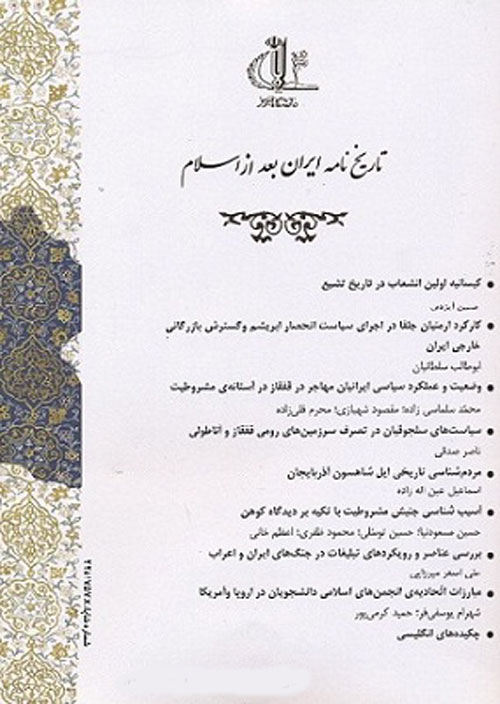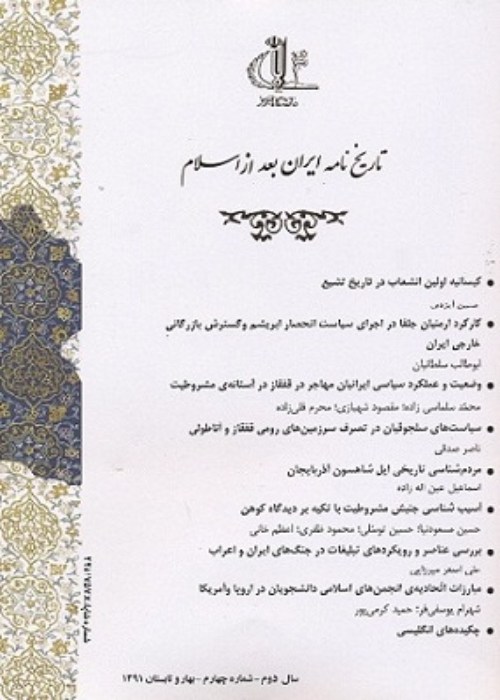فهرست مطالب

نشریه تاریخ نامه ایران بعد از اسلام
پیاپی 23 (تابستان 1399)
- تاریخ انتشار: 1399/09/03
- تعداد عناوین: 6
-
-
Pages 1-19
< p>The developmental process of architectural tradition of tower tombs in Azerbaijan during the 12th – 14th centuries (AD) is one of the basic questions in the Iranian history of architecture. Historically, the architectural constructions and decorations were developed in Nakhchivan by the end of 12th century. Based on the formulated doctrines of the former USSR academy, the late Seljukid architecture in Nakhchivan was indigenous and originated from the local innovations. Turkish art historians have classified the late Seljukid architecture in Nakhchivan as a variety of Turk – Islam tradition in the post- USSR years. These kinds of de- historized studies have not considered the socio- cultural relationships among Qazvin, Maragheh, Tabriz and Nakhchivan within the Iranian cultural context. The main aim of this study is to investigate the general specifications of the 12th – 14th centuries (AD) architecture of the tower tombs in Nakhchivan and Maragheh to examine their artistic and technical interactions appeared in the glorious architectural monuments during the Iranian Late Seljukid – Ilkhanid history of architecture. Methodologically, the origin of Nakhchivani tower tombs should be sought in the architectural manner of Maragheh due to the chronological order of their existing Persian and Arabic inscriptions. Although the USSR and Turkish decontextualized subjectivities in the architectural history of Nakhchivan are not well-reviewed, the architecture of the tower tombs in the Late Seljukid Nakhchivan has a processual trajectory initiated from the early Seljukid Kharāghān in Qazvin to the late Seljukid Maragheh and then the Nakhchivani manner of Ajami Nashawi.
Keywords: Azerbaijan, De- historization, Iranian history of architecture, Late Seljukid, Maragheh, Nakhchivan, Tower tombs -
Pages 21-44
Iran in the 19th century was different in foreign policy perspective. The catastrophic failures in Russo-Persian wars, the partition of Caucuses form Iran and the Tsars’ plans for accessing southern seas of Iran, British rule over India and Southern Indian Ocean waterways, all revived the importance of Iran as a buffer country in the Eastern policy of London politicians; events which transformed Iran into a center for Russian-British Bipolar Paradigm rivalry. The Iranian politicians acknowledging the dangers of such dual external rule were seeking a third power to decrease the pressure of their Northern-Southern neighbors. Qajar politicians believed that a third power would be a better balancer against Russia and Britain and would be assisting in the protecting national independence and territorial integrity. On the other side, America as a developed country, which set aside civil wars successfully, with the slogan of friendship and trade, was eager to establish political relations with countries like Iran and sign amity and trade agreements. This was the circumstances in which diplomatic relations between Iran and the US was established in the 19th century (AD).
Keywords: Iran, Qajar, America, Diplomatic Relations, Third Power Policy -
Pages 45-68
During Qajar era, superstition and anti-superstition have had great impact on Iran's political thought. Superstitious context as an irrational process and major obstacle to the growth of political thought in Iran, exhorted the society towards subjectivist and reductionist approach. Rational intellectuals, on the other hand, endeavored to erode superstitious trends for pushing the society towards rationality and development. This article with a qualitative historical and analytical methodology and through collecting the library data tries to answer the question that "how superstitious culture had influenced the political thought of Iran during the Qajar period?" The hypothesis of the research is that the culture of superstition and irrationality through subjectivism and reductionism influenced the political thought of Iran during Qajar era, which in its turn led to the "intellectual despotism" and consequently to the "political tyranny". Based on the Giddens conception of the interaction between structure and agency, the article concludes that the contextual factors notably the superstitious culture led to the despotic mindset of Iranian rulers during Qajar period.
Keywords: Political Thought, Superstition, rationality, Development, Qajar Era, Iran -
Pages 69-100
The second earliest published contemporary account that mentions and discusses Shah Esmaʿil I, the founder of the Safavid dynasty, his family, his rise to power, as well as his Qezelbash followers was a report published in Italian in 1506. This article offers a translation and an analysis of this report, plus four letters that are attached to this report which shed light on the role that the Sophy played in European anti-Ottoman politics.
Keywords: Shah Esma`il, Qizilbash, Messianism, Bayazid II, Ottoman-European conflict -
Pages 101-122Sultanieh has been one of the places which in Ilkhanid's period came to centrality and till many years after the downfall of Ilkhanids has been influential to its surrounding areas and has been influenced in return as well. One of such nearby areas which grew in light of the centrality and the political and economical importance of Sultanieh was in Dargazin to the west of Sultanieh. The economical and security needs of the capital, and the gaining support of the religious groups and scholars, have been three main factors in paying attention to the surrounding areas.The findings show that the necessity of ensuring the security of the capital and its economical needs, along with the geographical and political location of Dargazin, has played an important role on the interconnection of these two areas and the historical evolution of Dargazin. This study tries to benefit from the historical sources in order to examine the effect of Sultanieh centrality on the situation in Dargazin, and to determine the historical connection between the two cities in the political and social fields, and to explain some changes in this regard. This study is a library and source analysis research and the information is organized and analyzed after being collected.Keywords: Ilkhanid, Sultanieh, Hamadan, Dargazin, A'lam
-
Pages 123-147Japan was the first Asian nation in the nineteenth century which successfully implemented modernization. Therefore, to ensure its economic progress it sought new markets to sell its products. Iran, also with various motivations, to compensate for its backwardness sought to develop its relations with Japan. The present study attempts to study the ups and downs of trade relations between Iran and Japan in the contemporary era. Based on its findings, the study reveals that the First World War and the Bolshevik revolution in Russia boosted the trade between Iran and Japan and Japan became one of the Iran's top ten trade partners and the Japanese products officially entered Iran. Due to official relations, the trade activities between the two nations entered a new phase. Iran needed to be industrialized. Therefore, it hired Japanese experts and specialists to accelerate its progress. The trade balance between the two nations was equal in the beginning years of the Reza Shah era but gradually the Japanese benefitted more and this process continued.Keywords: Iran, Japan -Trade Relations, Nāser-al-dīn Shah, Reza Shah


